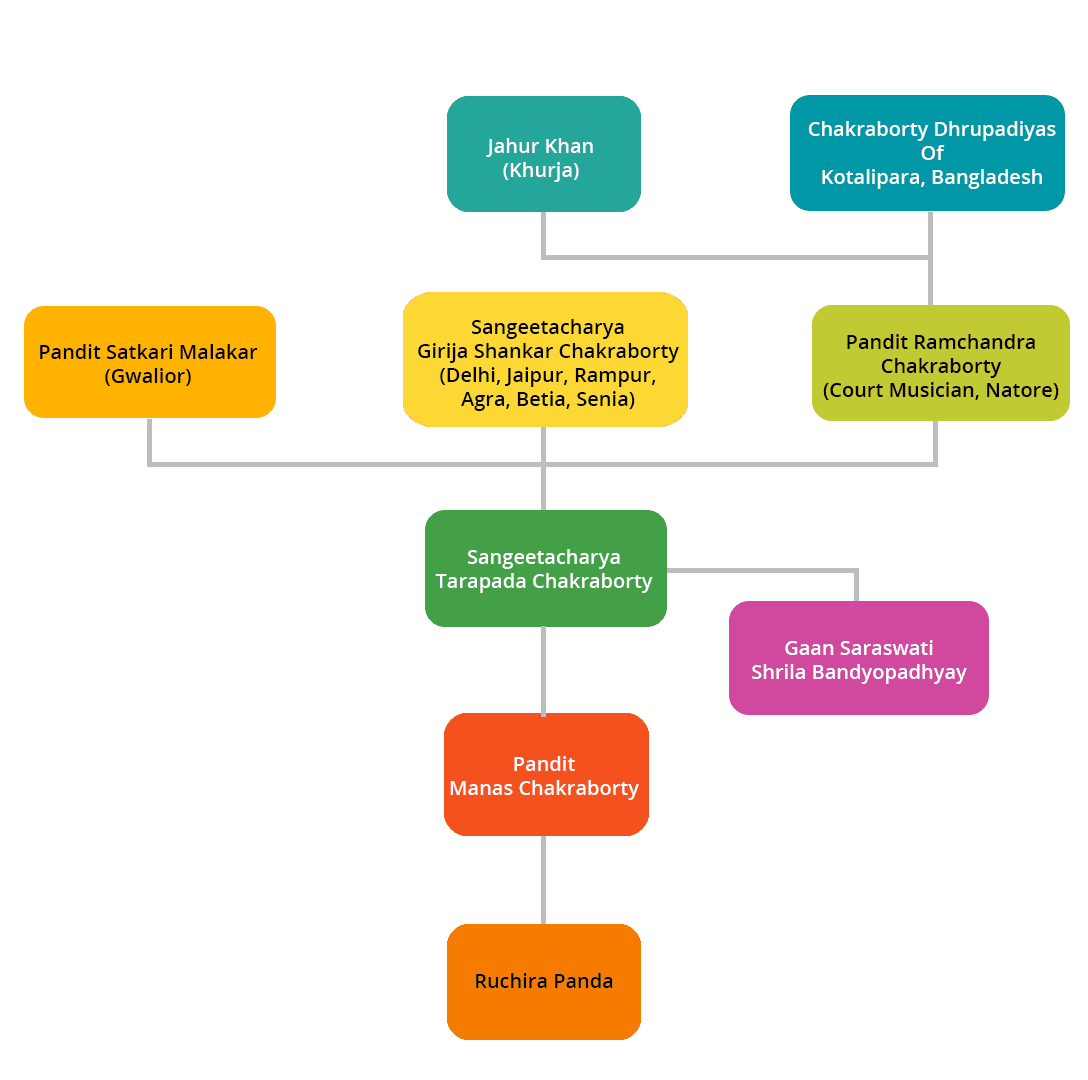Kotali Gharana

Sangeetacharya Tarapada Chakraborty, despite being the most successful Khayaliya from Bengal in the Indian Classical conference circuit of the 1950s and 1960s, eventually became a household name because of his short-form Bengali Raag Pradhan/ Rag Pradhan. Constrained in duration by the limitations of the vinyl records, this captured, in about 3.5 minutes, a condensed rendition of a Raga set to romantic or spiritual lyrics, reminiscent of the sensibilities of that time. This space was also inhabited by the other stalwarts, such as Pandit Jnanendra Prasad Goswamy, Pandit Vishmadev Chattopadhyay, Pandit Chinmoy Lahiri, Pandit Prasun Banerjee and others. Away from the high-brow glare of the Art Music of now-Barowari classical conference, Ragas thus took a firm root in the middle class Bengali household.
In “Shrabono Megh Maya Chhailo” from Hindusthan Records, published in 1936, we see some of his earlier attempts along this road. It sounds more like a Drut Khayal in Bengali, liberally adorned with lightning-speed taans, and was considered standard fare in those days.
Those fireworks were signed, sealed and delivered in less than three minutes. Fifteen-twenty years down the line, we see where it was headed in “Bone Bone Papiya”, where the treatment has moved away from Khayal, and has acquired a more accessible format. Sapat Taans and his famous Halak Taans have been dropped and Bol-Vistar is now prominent. The modulations now paint a mellower art from, captured in about four minutes.
His son, Pandit Manas Chakraborty, created a different musical form out of it and made it an essential concluding piece of his classical concerts for more than a decade. He introduced a long improvised Vistar ( Raga elaboration ) section, to elevate its status in Ragdari and gravitas, which was at the same time interspersed with lighter modulations. The length of a rendition went to 15-25 minutes, matching the long-form Bengali Bandishi Thumri made popular by him.
He made a significant change in the tone, structure and subtext of the lyrics, which has always been the hallmark of the Kotali Gharana. It started to fall in line with modern Bengali poetry of the 1970s and 1980s.
Mixed with his legendary mijaz, ragdari and aesthetics, it was the perfect recipe for the nouveau Bengali classical connoisseur and became superhits. In West Bengal, the conference-goers all had their favorites, and would clamor for one as soon as the more serious business in a concert got wrapped up.
His penchant for new compositions, and perennial dislike for repetition led him to create many fully-fleshed-out compositions right on stage. ( Freestyle Rap musicians of today should take note.) In one such on-the-fly sojourn into the unknown, he made up [approximately] these lines as he sang:
তবে কেন এতদূর বন্দরে ডেকে নিয়ে গেলে
ইথাকার চাঁদকে , কবেকার রাতে ফেলে,
এ শহরে এ নিয়ন আলো জ্বেলে দিলে
[ Why then you summoned me
to this distant harbour
Why you left the Ithaca moon
in the distant dark
And flooded my city in neon lights. ]
Obviously, these lyrics were more like a rock ballad the way we know it, in tune with Mohiner Ghoraguli, Indian Ocean and Springsteen, than the standard Indian light classical fare. In the hands of a visionary classical master, the effect was electric. Right after the concert, a bunch of listeners came from the concert hall and descended on his home, asking about the meaning of the song. Apparently “Ithaca” had flummoxed them.
As it normally happens in Bengal, this popularity irked a couple of upcoming musicians, who claimed that Bengali is not the language of choice in Hindustani classical. This, when, in Maharashtra, there has been a long tradition of ending a classical concert with Marathi Abhangs and beautifully elaborated Marathi Natyageets, and when the orthodox Latin operatic productions of Europe have been largely superseded by English, Spanish and Russian ones. Despite the distraction, this linguistic battle, therefore, was won hands down by Bengal.
In the Bengal conference circuit, it is high time we revived this long-format Bengali Raag Pradhan/ Rag Pradhan, once sculpted live for one and a half decades by a born improviser, until he had created enough, and went into other uncharted vistas to explore, as was his style. The Kotali style. [ Excerpted ]